Unit 13 Computing Research Project: AI and Urban Air Pollution
VerifiedAdded on 2021/11/25
|17
|5322
|231
Project
AI Summary
This document presents a research proposal by a student focusing on the application of Artificial Intelligence (AI) in addressing urban air pollution. The project explores the role of AI and the Internet of Things (IoT) in environmental management, specifically examining the use of IoT devices for air pollution monitoring and data collection. The proposal outlines the research question, objectives, and the student's interest in understanding IoT applications, their success in tackling air pollution, and the importance of AI in this context. It includes a literature review, proposed research methodologies (case study, survey), and a timeline of activities. The student plans to use quantitative and qualitative research methods to analyze the data and aims to produce two assignments addressing learning outcomes related to the project. The project also covers the benefits of IoT for businesses and consumers, the Industrial Internet of Things (IIoT), and the importance of security in IoT solutions, with a focus on real-time pollution monitoring and predictive analytics to create pollution maps for countermeasures. The research is designed to contribute to the understanding and application of AI and IoT in creating smarter and more responsive urban environments.
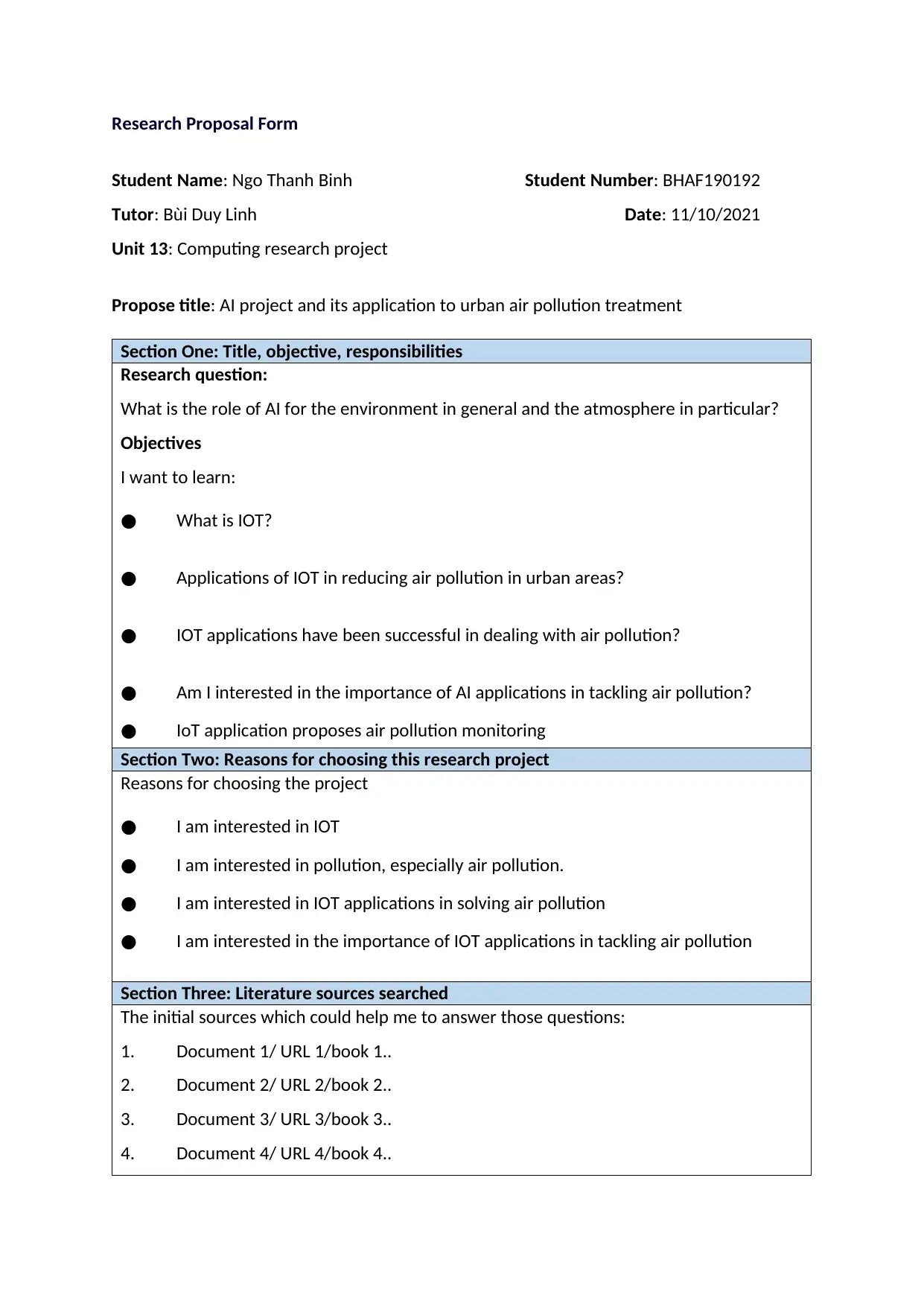
Research Proposal Form
Student Name: Ngo Thanh Binh Student Number: BHAF190192
Tutor: Bùi Duy Linh Date: 11/10/2021
Unit 13: Computing research project
Propose title: AI project and its application to urban air pollution treatment
Section One: Title, objective, responsibilities
Research question:
What is the role of AI for the environment in general and the atmosphere in particular?
Objectives
I want to learn:
● What is IOT?
● Applications of IOT in reducing air pollution in urban areas?
● IOT applications have been successful in dealing with air pollution?
● Am I interested in the importance of AI applications in tackling air pollution?
● IoT application proposes air pollution monitoring
Section Two: Reasons for choosing this research project
Reasons for choosing the project
● I am interested in IOT
● I am interested in pollution, especially air pollution.
● I am interested in IOT applications in solving air pollution
● I am interested in the importance of IOT applications in tackling air pollution
Section Three: Literature sources searched
The initial sources which could help me to answer those questions:
1. Document 1/ URL 1/book 1..
2. Document 2/ URL 2/book 2..
3. Document 3/ URL 3/book 3..
4. Document 4/ URL 4/book 4..
Student Name: Ngo Thanh Binh Student Number: BHAF190192
Tutor: Bùi Duy Linh Date: 11/10/2021
Unit 13: Computing research project
Propose title: AI project and its application to urban air pollution treatment
Section One: Title, objective, responsibilities
Research question:
What is the role of AI for the environment in general and the atmosphere in particular?
Objectives
I want to learn:
● What is IOT?
● Applications of IOT in reducing air pollution in urban areas?
● IOT applications have been successful in dealing with air pollution?
● Am I interested in the importance of AI applications in tackling air pollution?
● IoT application proposes air pollution monitoring
Section Two: Reasons for choosing this research project
Reasons for choosing the project
● I am interested in IOT
● I am interested in pollution, especially air pollution.
● I am interested in IOT applications in solving air pollution
● I am interested in the importance of IOT applications in tackling air pollution
Section Three: Literature sources searched
The initial sources which could help me to answer those questions:
1. Document 1/ URL 1/book 1..
2. Document 2/ URL 2/book 2..
3. Document 3/ URL 3/book 3..
4. Document 4/ URL 4/book 4..
Paraphrase This Document
Need a fresh take? Get an instant paraphrase of this document with our AI Paraphraser
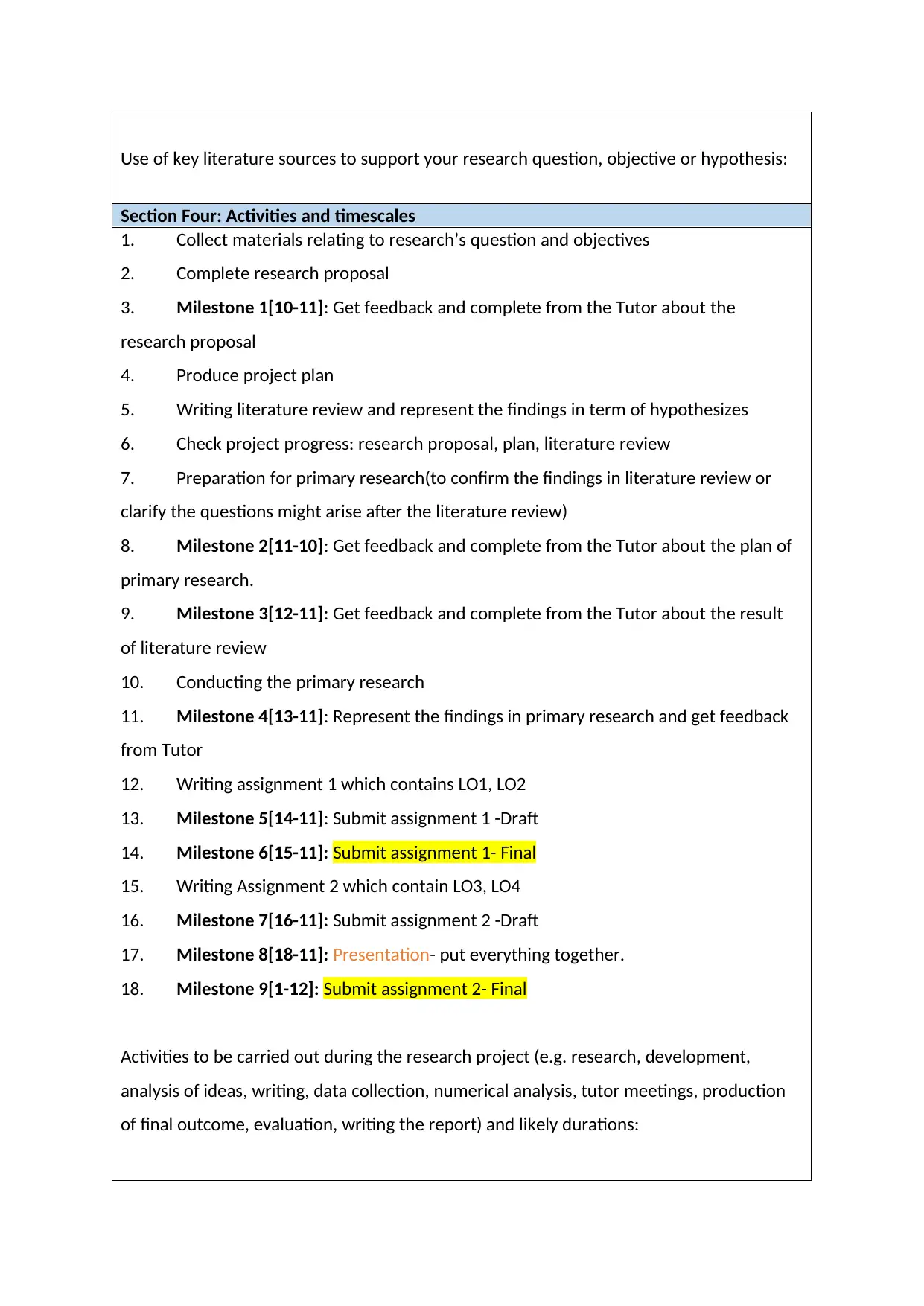
Use of key literature sources to support your research question, objective or hypothesis:
Section Four: Activities and timescales
1. Collect materials relating to research’s question and objectives
2. Complete research proposal
3. Milestone 1[10-11]: Get feedback and complete from the Tutor about the
research proposal
4. Produce project plan
5. Writing literature review and represent the findings in term of hypothesizes
6. Check project progress: research proposal, plan, literature review
7. Preparation for primary research(to confirm the findings in literature review or
clarify the questions might arise after the literature review)
8. Milestone 2[11-10]: Get feedback and complete from the Tutor about the plan of
primary research.
9. Milestone 3[12-11]: Get feedback and complete from the Tutor about the result
of literature review
10. Conducting the primary research
11. Milestone 4[13-11]: Represent the findings in primary research and get feedback
from Tutor
12. Writing assignment 1 which contains LO1, LO2
13. Milestone 5[14-11]: Submit assignment 1 -Draft
14. Milestone 6[15-11]: Submit assignment 1- Final
15. Writing Assignment 2 which contain LO3, LO4
16. Milestone 7[16-11]: Submit assignment 2 -Draft
17. Milestone 8[18-11]: Presentation- put everything together.
18. Milestone 9[1-12]: Submit assignment 2- Final
Activities to be carried out during the research project (e.g. research, development,
analysis of ideas, writing, data collection, numerical analysis, tutor meetings, production
of final outcome, evaluation, writing the report) and likely durations:
Section Four: Activities and timescales
1. Collect materials relating to research’s question and objectives
2. Complete research proposal
3. Milestone 1[10-11]: Get feedback and complete from the Tutor about the
research proposal
4. Produce project plan
5. Writing literature review and represent the findings in term of hypothesizes
6. Check project progress: research proposal, plan, literature review
7. Preparation for primary research(to confirm the findings in literature review or
clarify the questions might arise after the literature review)
8. Milestone 2[11-10]: Get feedback and complete from the Tutor about the plan of
primary research.
9. Milestone 3[12-11]: Get feedback and complete from the Tutor about the result
of literature review
10. Conducting the primary research
11. Milestone 4[13-11]: Represent the findings in primary research and get feedback
from Tutor
12. Writing assignment 1 which contains LO1, LO2
13. Milestone 5[14-11]: Submit assignment 1 -Draft
14. Milestone 6[15-11]: Submit assignment 1- Final
15. Writing Assignment 2 which contain LO3, LO4
16. Milestone 7[16-11]: Submit assignment 2 -Draft
17. Milestone 8[18-11]: Presentation- put everything together.
18. Milestone 9[1-12]: Submit assignment 2- Final
Activities to be carried out during the research project (e.g. research, development,
analysis of ideas, writing, data collection, numerical analysis, tutor meetings, production
of final outcome, evaluation, writing the report) and likely durations:
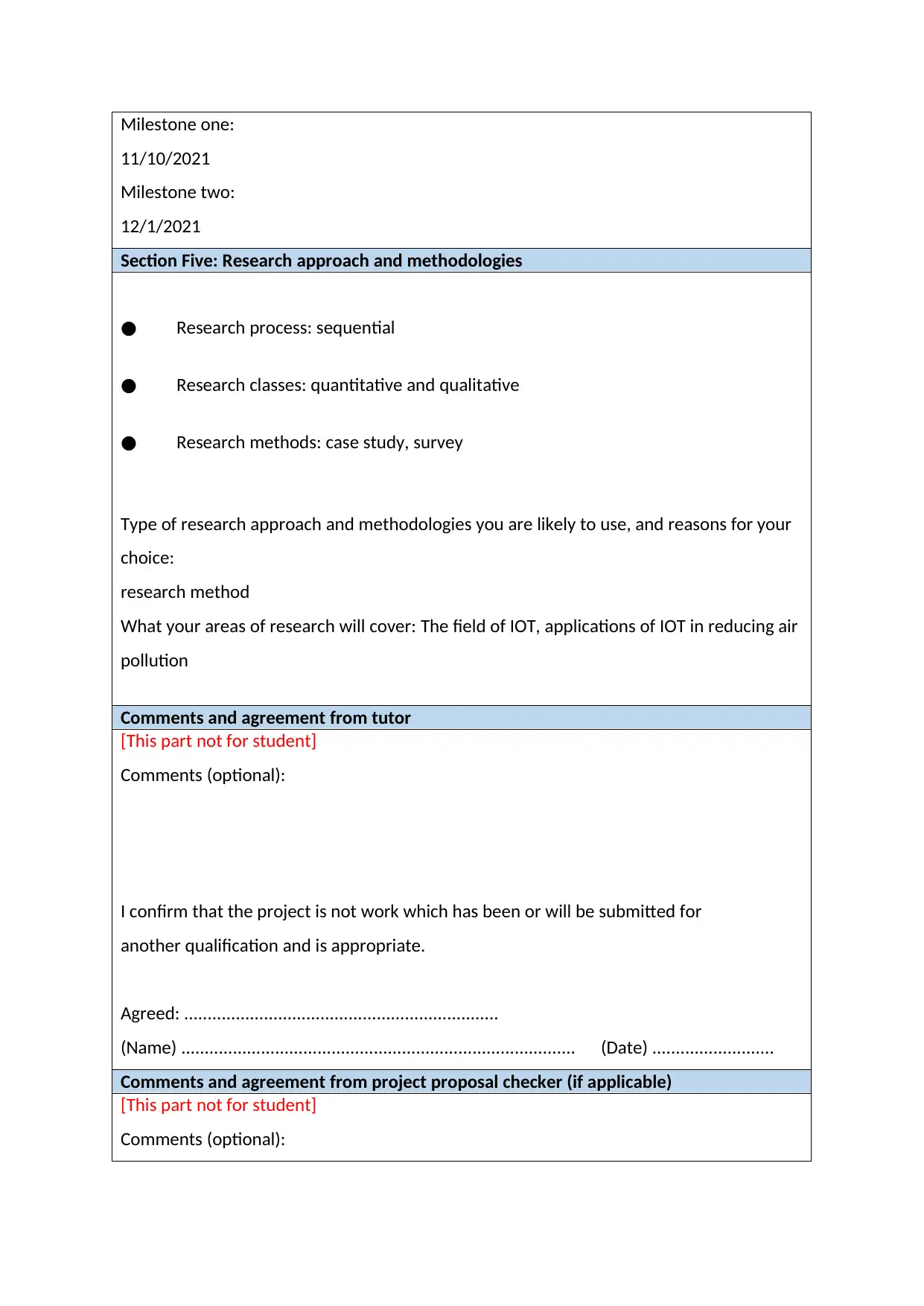
Milestone one:
11/10/2021
Milestone two:
12/1/2021
Section Five: Research approach and methodologies
● Research process: sequential
● Research classes: quantitative and qualitative
● Research methods: case study, survey
Type of research approach and methodologies you are likely to use, and reasons for your
choice:
research method
What your areas of research will cover: The field of IOT, applications of IOT in reducing air
pollution
Comments and agreement from tutor
[This part not for student]
Comments (optional):
I confirm that the project is not work which has been or will be submitted for
another qualification and is appropriate.
Agreed: ...................................................................
(Name) .................................................................................... (Date) ..........................
Comments and agreement from project proposal checker (if applicable)
[This part not for student]
Comments (optional):
11/10/2021
Milestone two:
12/1/2021
Section Five: Research approach and methodologies
● Research process: sequential
● Research classes: quantitative and qualitative
● Research methods: case study, survey
Type of research approach and methodologies you are likely to use, and reasons for your
choice:
research method
What your areas of research will cover: The field of IOT, applications of IOT in reducing air
pollution
Comments and agreement from tutor
[This part not for student]
Comments (optional):
I confirm that the project is not work which has been or will be submitted for
another qualification and is appropriate.
Agreed: ...................................................................
(Name) .................................................................................... (Date) ..........................
Comments and agreement from project proposal checker (if applicable)
[This part not for student]
Comments (optional):
⊘ This is a preview!⊘
Do you want full access?
Subscribe today to unlock all pages.

Trusted by 1+ million students worldwide
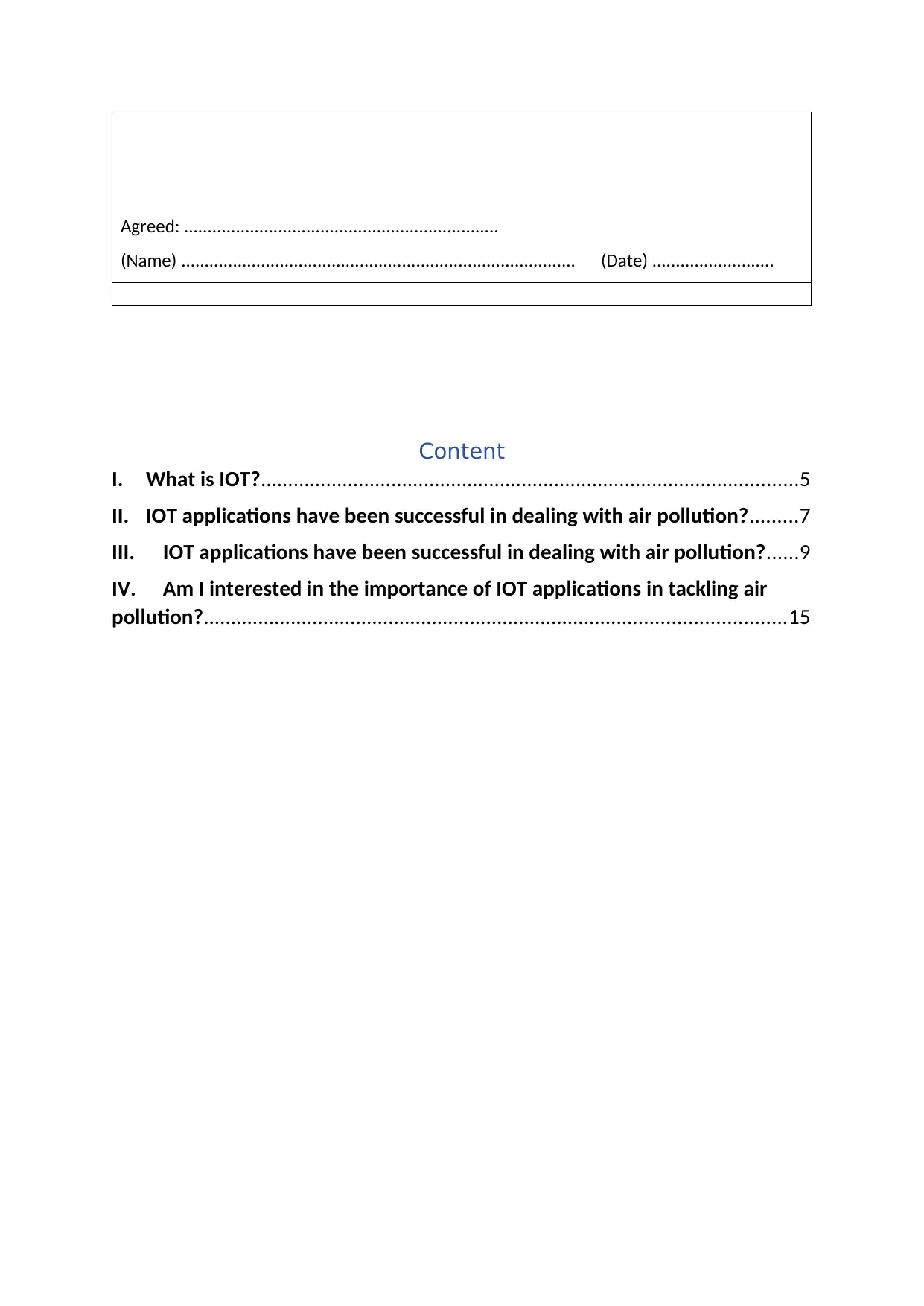
Agreed: ...................................................................
(Name) .................................................................................... (Date) ..........................
Content
I. What is IOT?...................................................................................................5
II. IOT applications have been successful in dealing with air pollution?.........7
III. IOT applications have been successful in dealing with air pollution?......9
IV. Am I interested in the importance of IOT applications in tackling air
pollution?...........................................................................................................15
(Name) .................................................................................... (Date) ..........................
Content
I. What is IOT?...................................................................................................5
II. IOT applications have been successful in dealing with air pollution?.........7
III. IOT applications have been successful in dealing with air pollution?......9
IV. Am I interested in the importance of IOT applications in tackling air
pollution?...........................................................................................................15
Paraphrase This Document
Need a fresh take? Get an instant paraphrase of this document with our AI Paraphraser
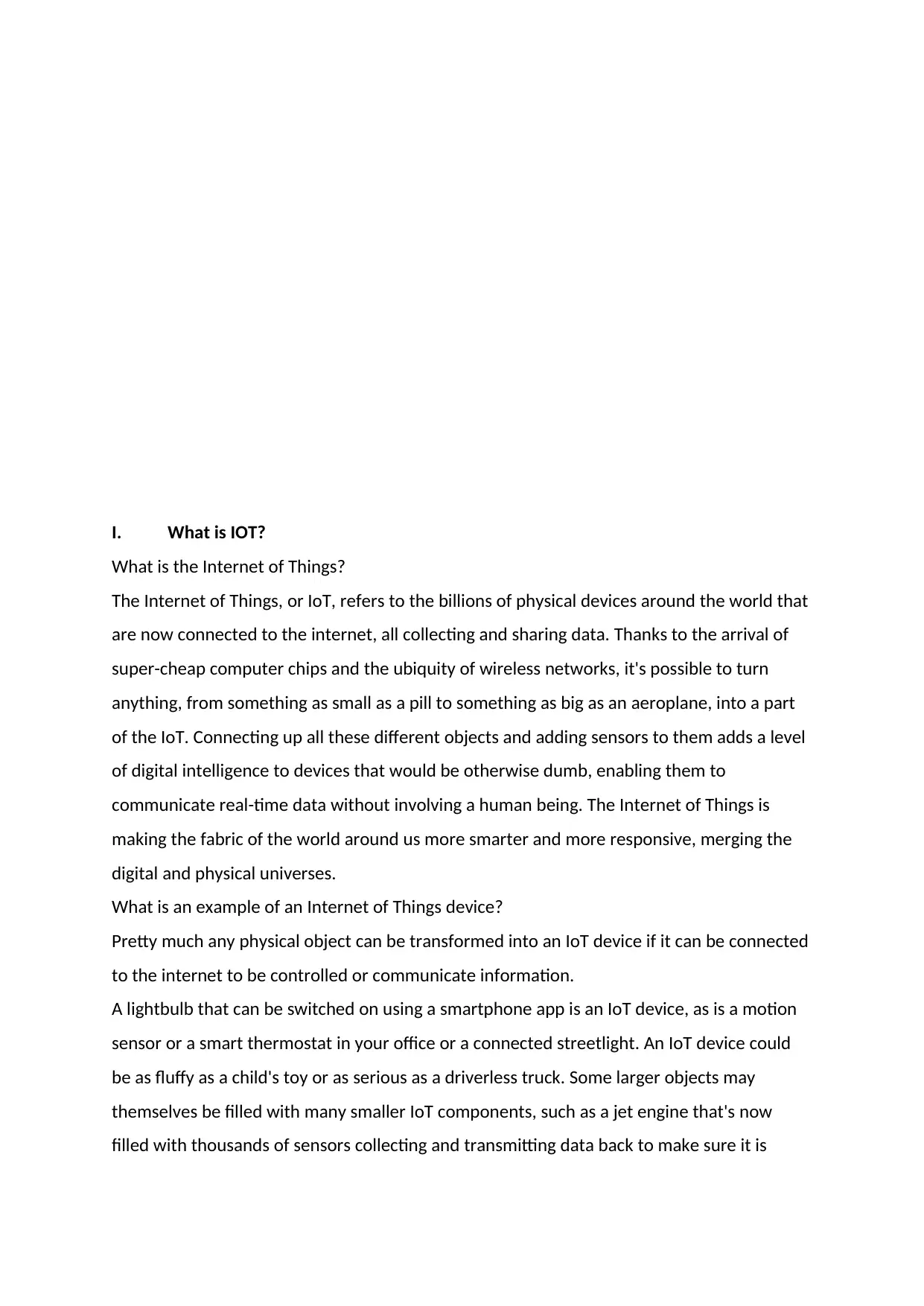
I. What is IOT?
What is the Internet of Things?
The Internet of Things, or IoT, refers to the billions of physical devices around the world that
are now connected to the internet, all collecting and sharing data. Thanks to the arrival of
super-cheap computer chips and the ubiquity of wireless networks, it's possible to turn
anything, from something as small as a pill to something as big as an aeroplane, into a part
of the IoT. Connecting up all these different objects and adding sensors to them adds a level
of digital intelligence to devices that would be otherwise dumb, enabling them to
communicate real-time data without involving a human being. The Internet of Things is
making the fabric of the world around us more smarter and more responsive, merging the
digital and physical universes.
What is an example of an Internet of Things device?
Pretty much any physical object can be transformed into an IoT device if it can be connected
to the internet to be controlled or communicate information.
A lightbulb that can be switched on using a smartphone app is an IoT device, as is a motion
sensor or a smart thermostat in your office or a connected streetlight. An IoT device could
be as fluffy as a child's toy or as serious as a driverless truck. Some larger objects may
themselves be filled with many smaller IoT components, such as a jet engine that's now
filled with thousands of sensors collecting and transmitting data back to make sure it is
What is the Internet of Things?
The Internet of Things, or IoT, refers to the billions of physical devices around the world that
are now connected to the internet, all collecting and sharing data. Thanks to the arrival of
super-cheap computer chips and the ubiquity of wireless networks, it's possible to turn
anything, from something as small as a pill to something as big as an aeroplane, into a part
of the IoT. Connecting up all these different objects and adding sensors to them adds a level
of digital intelligence to devices that would be otherwise dumb, enabling them to
communicate real-time data without involving a human being. The Internet of Things is
making the fabric of the world around us more smarter and more responsive, merging the
digital and physical universes.
What is an example of an Internet of Things device?
Pretty much any physical object can be transformed into an IoT device if it can be connected
to the internet to be controlled or communicate information.
A lightbulb that can be switched on using a smartphone app is an IoT device, as is a motion
sensor or a smart thermostat in your office or a connected streetlight. An IoT device could
be as fluffy as a child's toy or as serious as a driverless truck. Some larger objects may
themselves be filled with many smaller IoT components, such as a jet engine that's now
filled with thousands of sensors collecting and transmitting data back to make sure it is
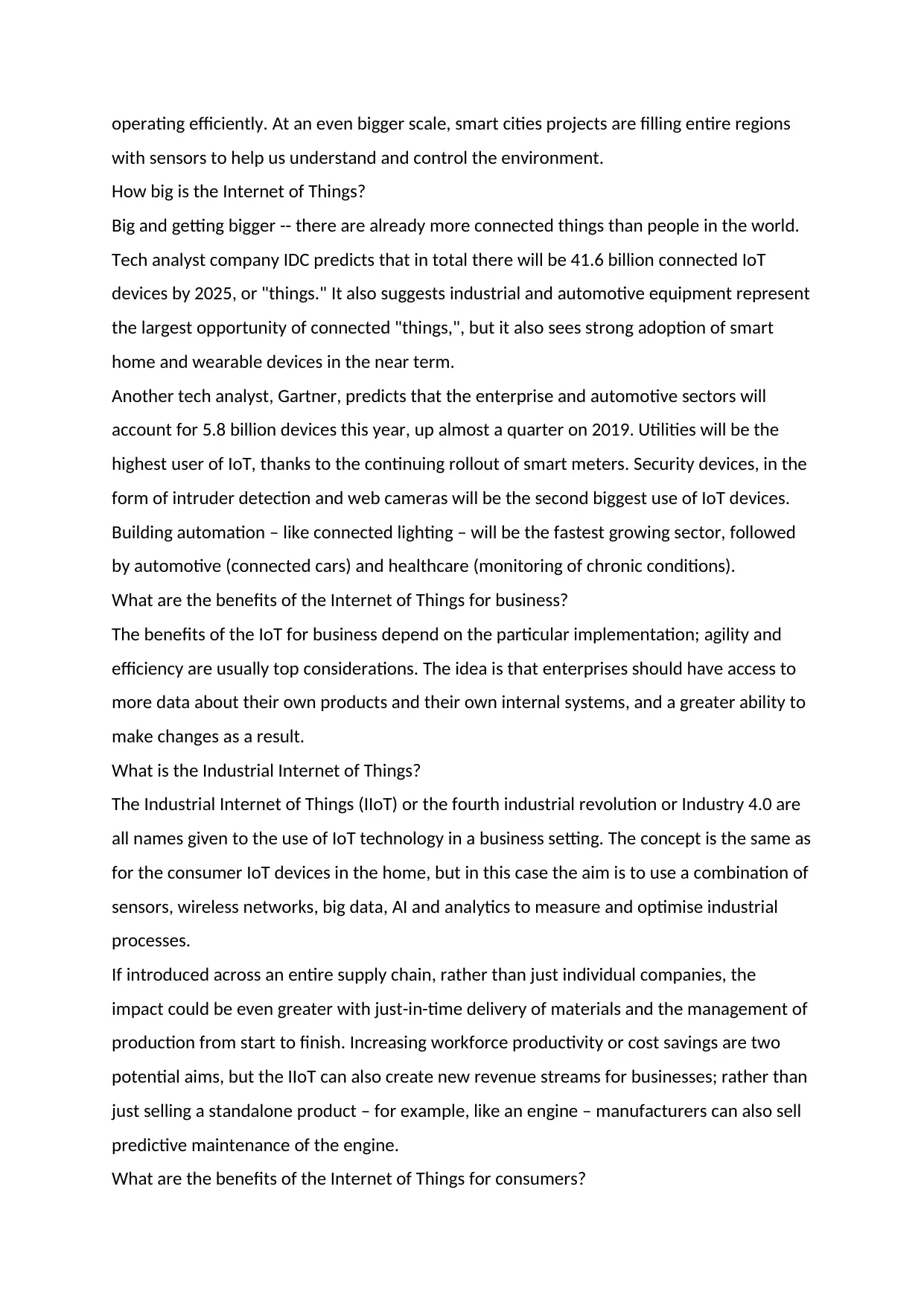
operating efficiently. At an even bigger scale, smart cities projects are filling entire regions
with sensors to help us understand and control the environment.
How big is the Internet of Things?
Big and getting bigger -- there are already more connected things than people in the world.
Tech analyst company IDC predicts that in total there will be 41.6 billion connected IoT
devices by 2025, or "things." It also suggests industrial and automotive equipment represent
the largest opportunity of connected "things,", but it also sees strong adoption of smart
home and wearable devices in the near term.
Another tech analyst, Gartner, predicts that the enterprise and automotive sectors will
account for 5.8 billion devices this year, up almost a quarter on 2019. Utilities will be the
highest user of IoT, thanks to the continuing rollout of smart meters. Security devices, in the
form of intruder detection and web cameras will be the second biggest use of IoT devices.
Building automation – like connected lighting – will be the fastest growing sector, followed
by automotive (connected cars) and healthcare (monitoring of chronic conditions).
What are the benefits of the Internet of Things for business?
The benefits of the IoT for business depend on the particular implementation; agility and
efficiency are usually top considerations. The idea is that enterprises should have access to
more data about their own products and their own internal systems, and a greater ability to
make changes as a result.
What is the Industrial Internet of Things?
The Industrial Internet of Things (IIoT) or the fourth industrial revolution or Industry 4.0 are
all names given to the use of IoT technology in a business setting. The concept is the same as
for the consumer IoT devices in the home, but in this case the aim is to use a combination of
sensors, wireless networks, big data, AI and analytics to measure and optimise industrial
processes.
If introduced across an entire supply chain, rather than just individual companies, the
impact could be even greater with just-in-time delivery of materials and the management of
production from start to finish. Increasing workforce productivity or cost savings are two
potential aims, but the IIoT can also create new revenue streams for businesses; rather than
just selling a standalone product – for example, like an engine – manufacturers can also sell
predictive maintenance of the engine.
What are the benefits of the Internet of Things for consumers?
with sensors to help us understand and control the environment.
How big is the Internet of Things?
Big and getting bigger -- there are already more connected things than people in the world.
Tech analyst company IDC predicts that in total there will be 41.6 billion connected IoT
devices by 2025, or "things." It also suggests industrial and automotive equipment represent
the largest opportunity of connected "things,", but it also sees strong adoption of smart
home and wearable devices in the near term.
Another tech analyst, Gartner, predicts that the enterprise and automotive sectors will
account for 5.8 billion devices this year, up almost a quarter on 2019. Utilities will be the
highest user of IoT, thanks to the continuing rollout of smart meters. Security devices, in the
form of intruder detection and web cameras will be the second biggest use of IoT devices.
Building automation – like connected lighting – will be the fastest growing sector, followed
by automotive (connected cars) and healthcare (monitoring of chronic conditions).
What are the benefits of the Internet of Things for business?
The benefits of the IoT for business depend on the particular implementation; agility and
efficiency are usually top considerations. The idea is that enterprises should have access to
more data about their own products and their own internal systems, and a greater ability to
make changes as a result.
What is the Industrial Internet of Things?
The Industrial Internet of Things (IIoT) or the fourth industrial revolution or Industry 4.0 are
all names given to the use of IoT technology in a business setting. The concept is the same as
for the consumer IoT devices in the home, but in this case the aim is to use a combination of
sensors, wireless networks, big data, AI and analytics to measure and optimise industrial
processes.
If introduced across an entire supply chain, rather than just individual companies, the
impact could be even greater with just-in-time delivery of materials and the management of
production from start to finish. Increasing workforce productivity or cost savings are two
potential aims, but the IIoT can also create new revenue streams for businesses; rather than
just selling a standalone product – for example, like an engine – manufacturers can also sell
predictive maintenance of the engine.
What are the benefits of the Internet of Things for consumers?
⊘ This is a preview!⊘
Do you want full access?
Subscribe today to unlock all pages.

Trusted by 1+ million students worldwide
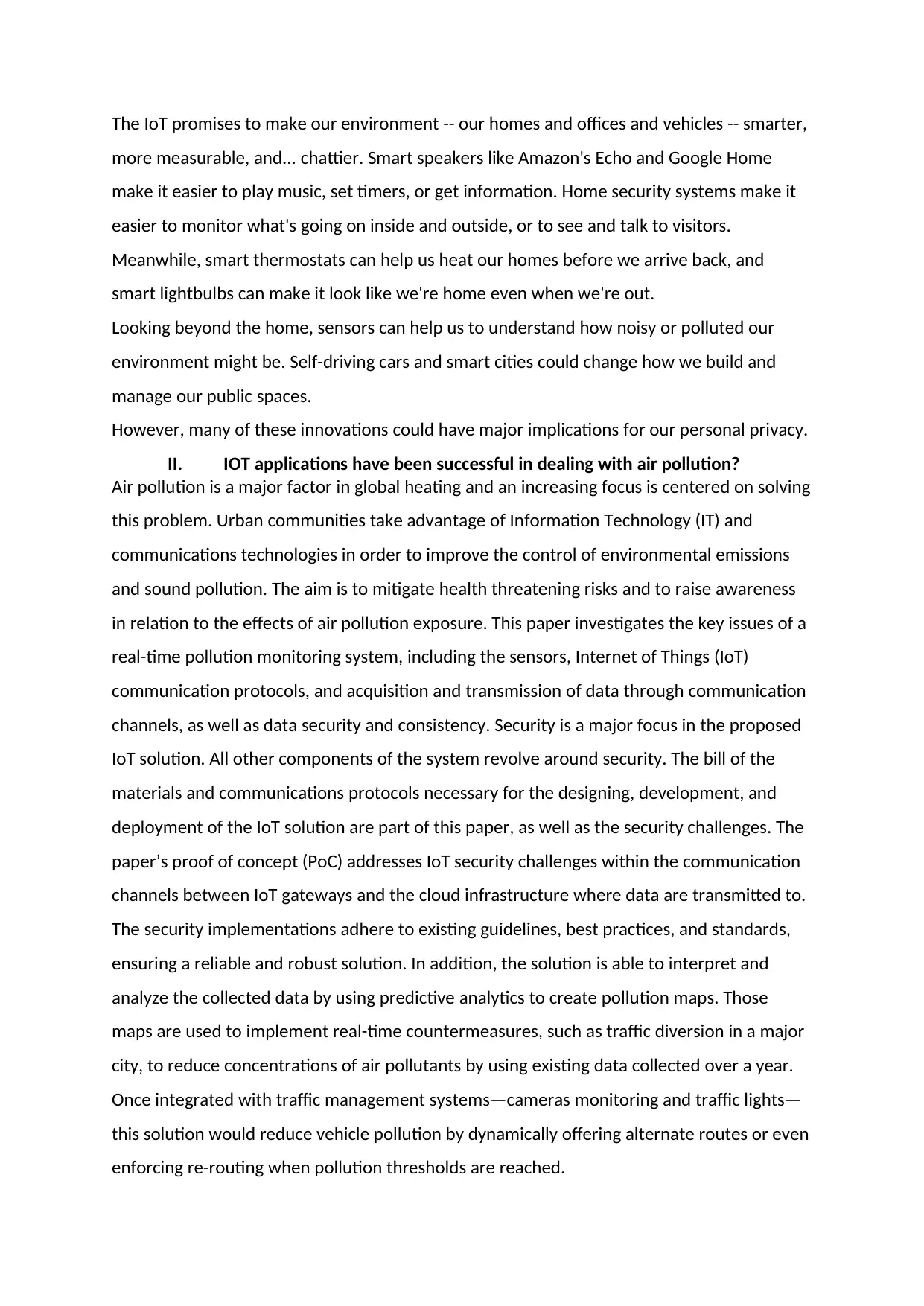
The IoT promises to make our environment -- our homes and offices and vehicles -- smarter,
more measurable, and... chattier. Smart speakers like Amazon's Echo and Google Home
make it easier to play music, set timers, or get information. Home security systems make it
easier to monitor what's going on inside and outside, or to see and talk to visitors.
Meanwhile, smart thermostats can help us heat our homes before we arrive back, and
smart lightbulbs can make it look like we're home even when we're out.
Looking beyond the home, sensors can help us to understand how noisy or polluted our
environment might be. Self-driving cars and smart cities could change how we build and
manage our public spaces.
However, many of these innovations could have major implications for our personal privacy.
II. IOT applications have been successful in dealing with air pollution?
Air pollution is a major factor in global heating and an increasing focus is centered on solving
this problem. Urban communities take advantage of Information Technology (IT) and
communications technologies in order to improve the control of environmental emissions
and sound pollution. The aim is to mitigate health threatening risks and to raise awareness
in relation to the effects of air pollution exposure. This paper investigates the key issues of a
real-time pollution monitoring system, including the sensors, Internet of Things (IoT)
communication protocols, and acquisition and transmission of data through communication
channels, as well as data security and consistency. Security is a major focus in the proposed
IoT solution. All other components of the system revolve around security. The bill of the
materials and communications protocols necessary for the designing, development, and
deployment of the IoT solution are part of this paper, as well as the security challenges. The
paper’s proof of concept (PoC) addresses IoT security challenges within the communication
channels between IoT gateways and the cloud infrastructure where data are transmitted to.
The security implementations adhere to existing guidelines, best practices, and standards,
ensuring a reliable and robust solution. In addition, the solution is able to interpret and
analyze the collected data by using predictive analytics to create pollution maps. Those
maps are used to implement real-time countermeasures, such as traffic diversion in a major
city, to reduce concentrations of air pollutants by using existing data collected over a year.
Once integrated with traffic management systems—cameras monitoring and traffic lights—
this solution would reduce vehicle pollution by dynamically offering alternate routes or even
enforcing re-routing when pollution thresholds are reached.
more measurable, and... chattier. Smart speakers like Amazon's Echo and Google Home
make it easier to play music, set timers, or get information. Home security systems make it
easier to monitor what's going on inside and outside, or to see and talk to visitors.
Meanwhile, smart thermostats can help us heat our homes before we arrive back, and
smart lightbulbs can make it look like we're home even when we're out.
Looking beyond the home, sensors can help us to understand how noisy or polluted our
environment might be. Self-driving cars and smart cities could change how we build and
manage our public spaces.
However, many of these innovations could have major implications for our personal privacy.
II. IOT applications have been successful in dealing with air pollution?
Air pollution is a major factor in global heating and an increasing focus is centered on solving
this problem. Urban communities take advantage of Information Technology (IT) and
communications technologies in order to improve the control of environmental emissions
and sound pollution. The aim is to mitigate health threatening risks and to raise awareness
in relation to the effects of air pollution exposure. This paper investigates the key issues of a
real-time pollution monitoring system, including the sensors, Internet of Things (IoT)
communication protocols, and acquisition and transmission of data through communication
channels, as well as data security and consistency. Security is a major focus in the proposed
IoT solution. All other components of the system revolve around security. The bill of the
materials and communications protocols necessary for the designing, development, and
deployment of the IoT solution are part of this paper, as well as the security challenges. The
paper’s proof of concept (PoC) addresses IoT security challenges within the communication
channels between IoT gateways and the cloud infrastructure where data are transmitted to.
The security implementations adhere to existing guidelines, best practices, and standards,
ensuring a reliable and robust solution. In addition, the solution is able to interpret and
analyze the collected data by using predictive analytics to create pollution maps. Those
maps are used to implement real-time countermeasures, such as traffic diversion in a major
city, to reduce concentrations of air pollutants by using existing data collected over a year.
Once integrated with traffic management systems—cameras monitoring and traffic lights—
this solution would reduce vehicle pollution by dynamically offering alternate routes or even
enforcing re-routing when pollution thresholds are reached.
Paraphrase This Document
Need a fresh take? Get an instant paraphrase of this document with our AI Paraphraser
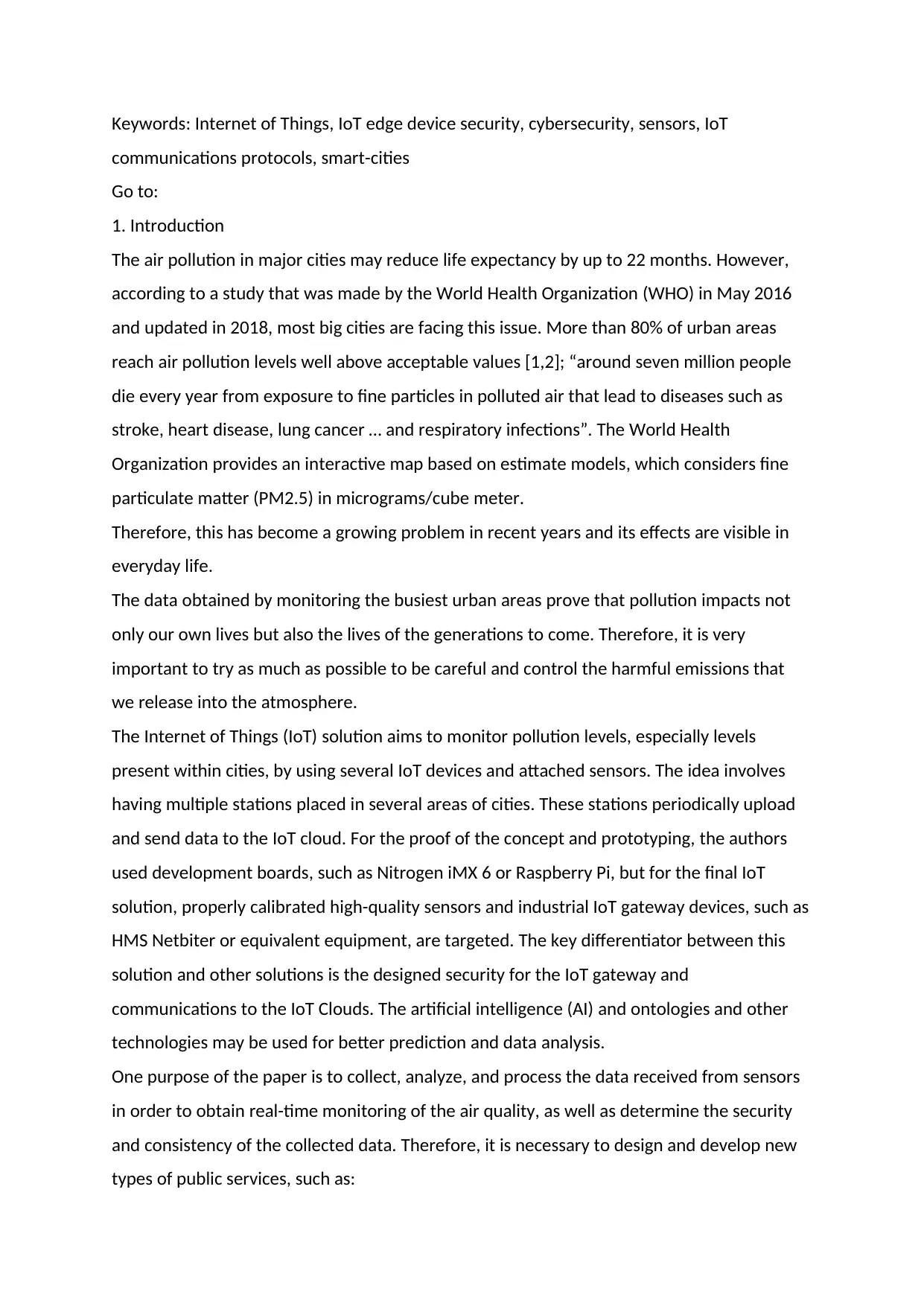
Keywords: Internet of Things, IoT edge device security, cybersecurity, sensors, IoT
communications protocols, smart-cities
Go to:
1. Introduction
The air pollution in major cities may reduce life expectancy by up to 22 months. However,
according to a study that was made by the World Health Organization (WHO) in May 2016
and updated in 2018, most big cities are facing this issue. More than 80% of urban areas
reach air pollution levels well above acceptable values [1,2]; “around seven million people
die every year from exposure to fine particles in polluted air that lead to diseases such as
stroke, heart disease, lung cancer … and respiratory infections”. The World Health
Organization provides an interactive map based on estimate models, which considers fine
particulate matter (PM2.5) in micrograms/cube meter.
Therefore, this has become a growing problem in recent years and its effects are visible in
everyday life.
The data obtained by monitoring the busiest urban areas prove that pollution impacts not
only our own lives but also the lives of the generations to come. Therefore, it is very
important to try as much as possible to be careful and control the harmful emissions that
we release into the atmosphere.
The Internet of Things (IoT) solution aims to monitor pollution levels, especially levels
present within cities, by using several IoT devices and attached sensors. The idea involves
having multiple stations placed in several areas of cities. These stations periodically upload
and send data to the IoT cloud. For the proof of the concept and prototyping, the authors
used development boards, such as Nitrogen iMX 6 or Raspberry Pi, but for the final IoT
solution, properly calibrated high-quality sensors and industrial IoT gateway devices, such as
HMS Netbiter or equivalent equipment, are targeted. The key differentiator between this
solution and other solutions is the designed security for the IoT gateway and
communications to the IoT Clouds. The artificial intelligence (AI) and ontologies and other
technologies may be used for better prediction and data analysis.
One purpose of the paper is to collect, analyze, and process the data received from sensors
in order to obtain real-time monitoring of the air quality, as well as determine the security
and consistency of the collected data. Therefore, it is necessary to design and develop new
types of public services, such as:
communications protocols, smart-cities
Go to:
1. Introduction
The air pollution in major cities may reduce life expectancy by up to 22 months. However,
according to a study that was made by the World Health Organization (WHO) in May 2016
and updated in 2018, most big cities are facing this issue. More than 80% of urban areas
reach air pollution levels well above acceptable values [1,2]; “around seven million people
die every year from exposure to fine particles in polluted air that lead to diseases such as
stroke, heart disease, lung cancer … and respiratory infections”. The World Health
Organization provides an interactive map based on estimate models, which considers fine
particulate matter (PM2.5) in micrograms/cube meter.
Therefore, this has become a growing problem in recent years and its effects are visible in
everyday life.
The data obtained by monitoring the busiest urban areas prove that pollution impacts not
only our own lives but also the lives of the generations to come. Therefore, it is very
important to try as much as possible to be careful and control the harmful emissions that
we release into the atmosphere.
The Internet of Things (IoT) solution aims to monitor pollution levels, especially levels
present within cities, by using several IoT devices and attached sensors. The idea involves
having multiple stations placed in several areas of cities. These stations periodically upload
and send data to the IoT cloud. For the proof of the concept and prototyping, the authors
used development boards, such as Nitrogen iMX 6 or Raspberry Pi, but for the final IoT
solution, properly calibrated high-quality sensors and industrial IoT gateway devices, such as
HMS Netbiter or equivalent equipment, are targeted. The key differentiator between this
solution and other solutions is the designed security for the IoT gateway and
communications to the IoT Clouds. The artificial intelligence (AI) and ontologies and other
technologies may be used for better prediction and data analysis.
One purpose of the paper is to collect, analyze, and process the data received from sensors
in order to obtain real-time monitoring of the air quality, as well as determine the security
and consistency of the collected data. Therefore, it is necessary to design and develop new
types of public services, such as:
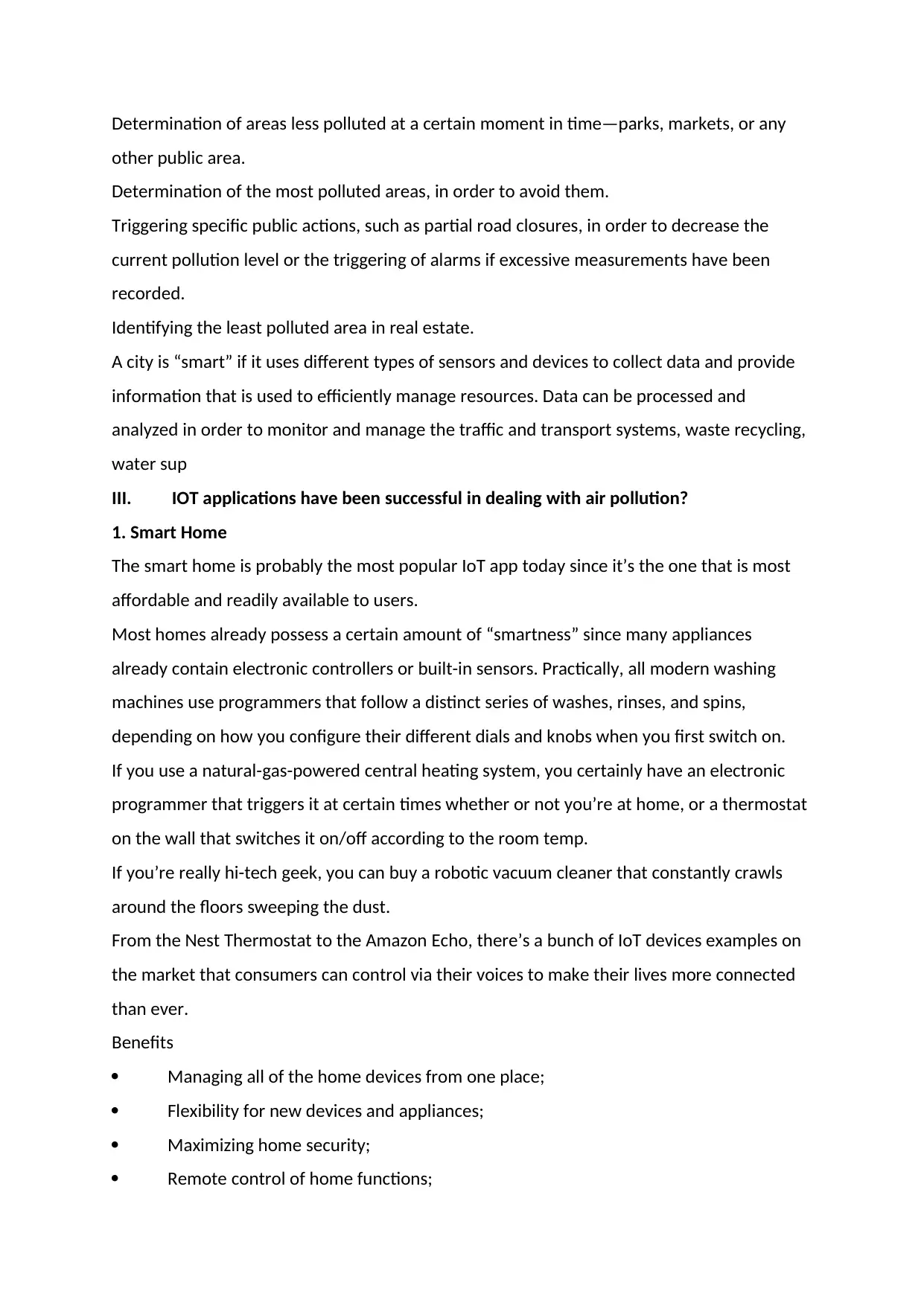
Determination of areas less polluted at a certain moment in time—parks, markets, or any
other public area.
Determination of the most polluted areas, in order to avoid them.
Triggering specific public actions, such as partial road closures, in order to decrease the
current pollution level or the triggering of alarms if excessive measurements have been
recorded.
Identifying the least polluted area in real estate.
A city is “smart” if it uses different types of sensors and devices to collect data and provide
information that is used to efficiently manage resources. Data can be processed and
analyzed in order to monitor and manage the traffic and transport systems, waste recycling,
water sup
III. IOT applications have been successful in dealing with air pollution?
1. Smart Home
The smart home is probably the most popular IoT app today since it’s the one that is most
affordable and readily available to users.
Most homes already possess a certain amount of “smartness” since many appliances
already contain electronic controllers or built-in sensors. Practically, all modern washing
machines use programmers that follow a distinct series of washes, rinses, and spins,
depending on how you configure their different dials and knobs when you first switch on.
If you use a natural-gas-powered central heating system, you certainly have an electronic
programmer that triggers it at certain times whether or not you’re at home, or a thermostat
on the wall that switches it on/off according to the room temp.
If you’re really hi-tech geek, you can buy a robotic vacuum cleaner that constantly crawls
around the floors sweeping the dust.
From the Nest Thermostat to the Amazon Echo, there’s a bunch of IoT devices examples on
the market that consumers can control via their voices to make their lives more connected
than ever.
Benefits
Managing all of the home devices from one place;
Flexibility for new devices and appliances;
Maximizing home security;
Remote control of home functions;
other public area.
Determination of the most polluted areas, in order to avoid them.
Triggering specific public actions, such as partial road closures, in order to decrease the
current pollution level or the triggering of alarms if excessive measurements have been
recorded.
Identifying the least polluted area in real estate.
A city is “smart” if it uses different types of sensors and devices to collect data and provide
information that is used to efficiently manage resources. Data can be processed and
analyzed in order to monitor and manage the traffic and transport systems, waste recycling,
water sup
III. IOT applications have been successful in dealing with air pollution?
1. Smart Home
The smart home is probably the most popular IoT app today since it’s the one that is most
affordable and readily available to users.
Most homes already possess a certain amount of “smartness” since many appliances
already contain electronic controllers or built-in sensors. Practically, all modern washing
machines use programmers that follow a distinct series of washes, rinses, and spins,
depending on how you configure their different dials and knobs when you first switch on.
If you use a natural-gas-powered central heating system, you certainly have an electronic
programmer that triggers it at certain times whether or not you’re at home, or a thermostat
on the wall that switches it on/off according to the room temp.
If you’re really hi-tech geek, you can buy a robotic vacuum cleaner that constantly crawls
around the floors sweeping the dust.
From the Nest Thermostat to the Amazon Echo, there’s a bunch of IoT devices examples on
the market that consumers can control via their voices to make their lives more connected
than ever.
Benefits
Managing all of the home devices from one place;
Flexibility for new devices and appliances;
Maximizing home security;
Remote control of home functions;
⊘ This is a preview!⊘
Do you want full access?
Subscribe today to unlock all pages.

Trusted by 1+ million students worldwide
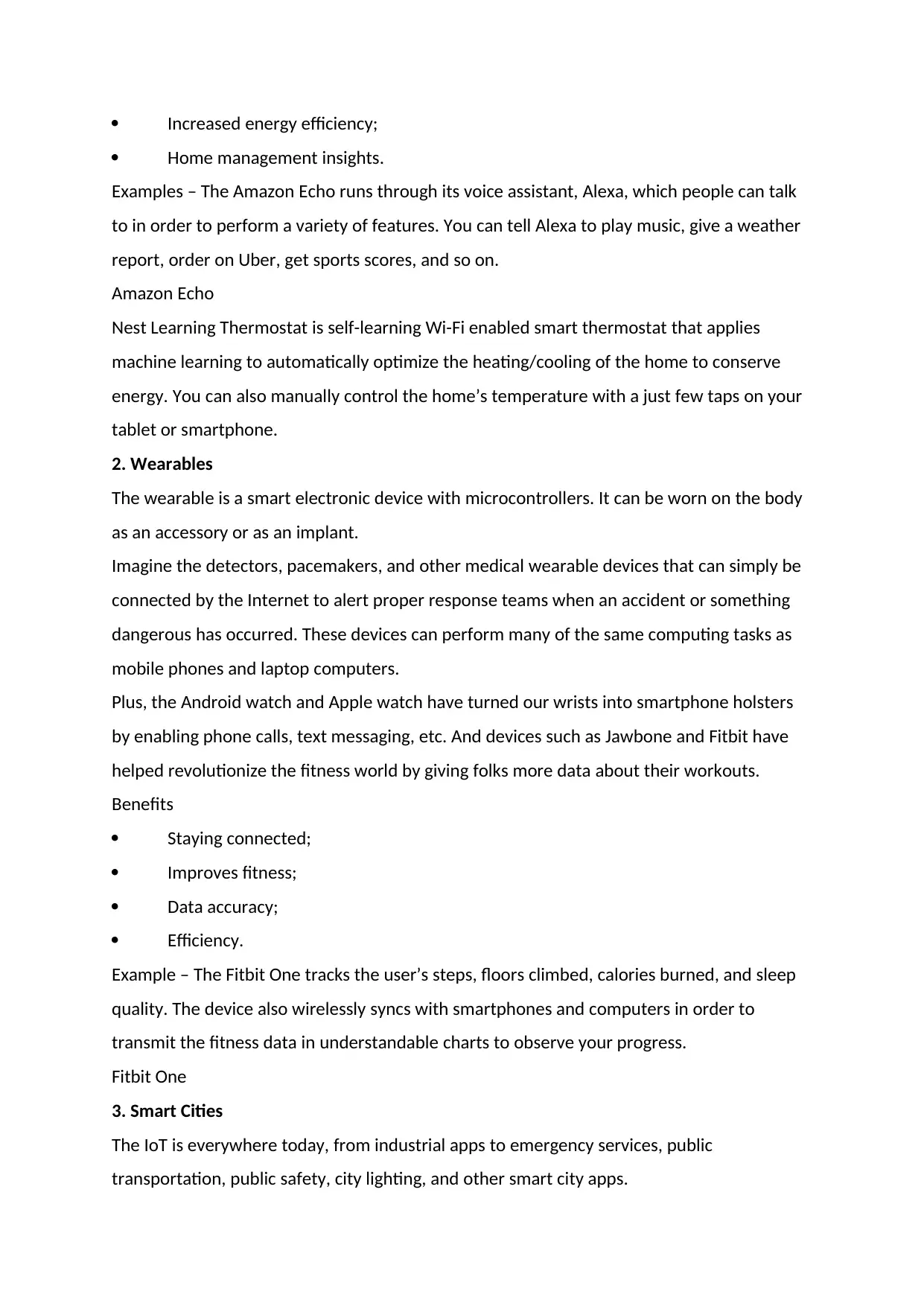
Increased energy efficiency;
Home management insights.
Examples – The Amazon Echo runs through its voice assistant, Alexa, which people can talk
to in order to perform a variety of features. You can tell Alexa to play music, give a weather
report, order on Uber, get sports scores, and so on.
Amazon Echo
Nest Learning Thermostat is self-learning Wi-Fi enabled smart thermostat that applies
machine learning to automatically optimize the heating/cooling of the home to conserve
energy. You can also manually control the home’s temperature with a just few taps on your
tablet or smartphone.
2. Wearables
The wearable is a smart electronic device with microcontrollers. It can be worn on the body
as an accessory or as an implant.
Imagine the detectors, pacemakers, and other medical wearable devices that can simply be
connected by the Internet to alert proper response teams when an accident or something
dangerous has occurred. These devices can perform many of the same computing tasks as
mobile phones and laptop computers.
Plus, the Android watch and Apple watch have turned our wrists into smartphone holsters
by enabling phone calls, text messaging, etc. And devices such as Jawbone and Fitbit have
helped revolutionize the fitness world by giving folks more data about their workouts.
Benefits
Staying connected;
Improves fitness;
Data accuracy;
Efficiency.
Example – The Fitbit One tracks the user’s steps, floors climbed, calories burned, and sleep
quality. The device also wirelessly syncs with smartphones and computers in order to
transmit the fitness data in understandable charts to observe your progress.
Fitbit One
3. Smart Cities
The IoT is everywhere today, from industrial apps to emergency services, public
transportation, public safety, city lighting, and other smart city apps.
Home management insights.
Examples – The Amazon Echo runs through its voice assistant, Alexa, which people can talk
to in order to perform a variety of features. You can tell Alexa to play music, give a weather
report, order on Uber, get sports scores, and so on.
Amazon Echo
Nest Learning Thermostat is self-learning Wi-Fi enabled smart thermostat that applies
machine learning to automatically optimize the heating/cooling of the home to conserve
energy. You can also manually control the home’s temperature with a just few taps on your
tablet or smartphone.
2. Wearables
The wearable is a smart electronic device with microcontrollers. It can be worn on the body
as an accessory or as an implant.
Imagine the detectors, pacemakers, and other medical wearable devices that can simply be
connected by the Internet to alert proper response teams when an accident or something
dangerous has occurred. These devices can perform many of the same computing tasks as
mobile phones and laptop computers.
Plus, the Android watch and Apple watch have turned our wrists into smartphone holsters
by enabling phone calls, text messaging, etc. And devices such as Jawbone and Fitbit have
helped revolutionize the fitness world by giving folks more data about their workouts.
Benefits
Staying connected;
Improves fitness;
Data accuracy;
Efficiency.
Example – The Fitbit One tracks the user’s steps, floors climbed, calories burned, and sleep
quality. The device also wirelessly syncs with smartphones and computers in order to
transmit the fitness data in understandable charts to observe your progress.
Fitbit One
3. Smart Cities
The IoT is everywhere today, from industrial apps to emergency services, public
transportation, public safety, city lighting, and other smart city apps.
Paraphrase This Document
Need a fresh take? Get an instant paraphrase of this document with our AI Paraphraser
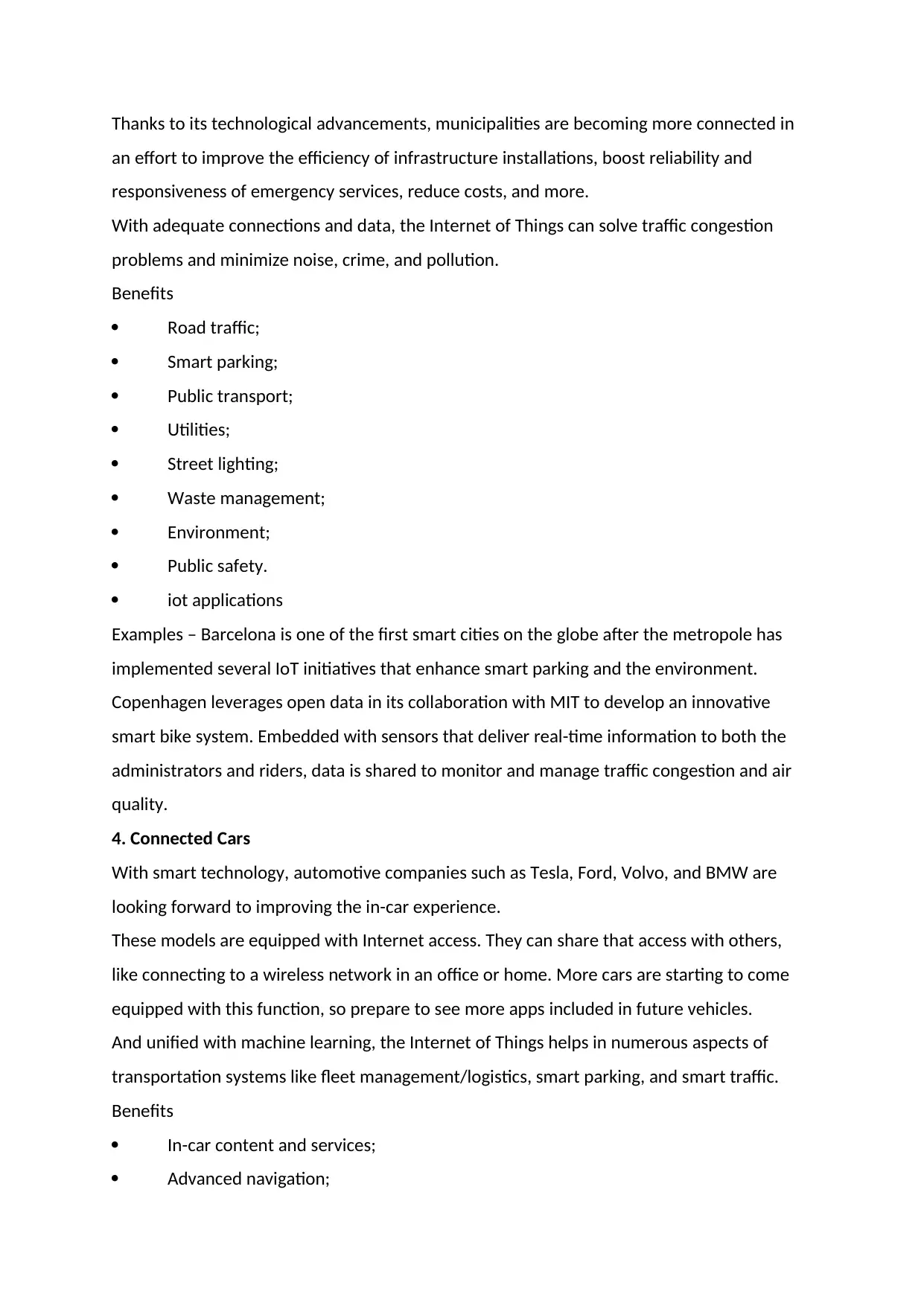
Thanks to its technological advancements, municipalities are becoming more connected in
an effort to improve the efficiency of infrastructure installations, boost reliability and
responsiveness of emergency services, reduce costs, and more.
With adequate connections and data, the Internet of Things can solve traffic congestion
problems and minimize noise, crime, and pollution.
Benefits
Road traffic;
Smart parking;
Public transport;
Utilities;
Street lighting;
Waste management;
Environment;
Public safety.
iot applications
Examples – Barcelona is one of the first smart cities on the globe after the metropole has
implemented several IoT initiatives that enhance smart parking and the environment.
Copenhagen leverages open data in its collaboration with MIT to develop an innovative
smart bike system. Embedded with sensors that deliver real-time information to both the
administrators and riders, data is shared to monitor and manage traffic congestion and air
quality.
4. Connected Cars
With smart technology, automotive companies such as Tesla, Ford, Volvo, and BMW are
looking forward to improving the in-car experience.
These models are equipped with Internet access. They can share that access with others,
like connecting to a wireless network in an office or home. More cars are starting to come
equipped with this function, so prepare to see more apps included in future vehicles.
And unified with machine learning, the Internet of Things helps in numerous aspects of
transportation systems like fleet management/logistics, smart parking, and smart traffic.
Benefits
In-car content and services;
Advanced navigation;
an effort to improve the efficiency of infrastructure installations, boost reliability and
responsiveness of emergency services, reduce costs, and more.
With adequate connections and data, the Internet of Things can solve traffic congestion
problems and minimize noise, crime, and pollution.
Benefits
Road traffic;
Smart parking;
Public transport;
Utilities;
Street lighting;
Waste management;
Environment;
Public safety.
iot applications
Examples – Barcelona is one of the first smart cities on the globe after the metropole has
implemented several IoT initiatives that enhance smart parking and the environment.
Copenhagen leverages open data in its collaboration with MIT to develop an innovative
smart bike system. Embedded with sensors that deliver real-time information to both the
administrators and riders, data is shared to monitor and manage traffic congestion and air
quality.
4. Connected Cars
With smart technology, automotive companies such as Tesla, Ford, Volvo, and BMW are
looking forward to improving the in-car experience.
These models are equipped with Internet access. They can share that access with others,
like connecting to a wireless network in an office or home. More cars are starting to come
equipped with this function, so prepare to see more apps included in future vehicles.
And unified with machine learning, the Internet of Things helps in numerous aspects of
transportation systems like fleet management/logistics, smart parking, and smart traffic.
Benefits
In-car content and services;
Advanced navigation;
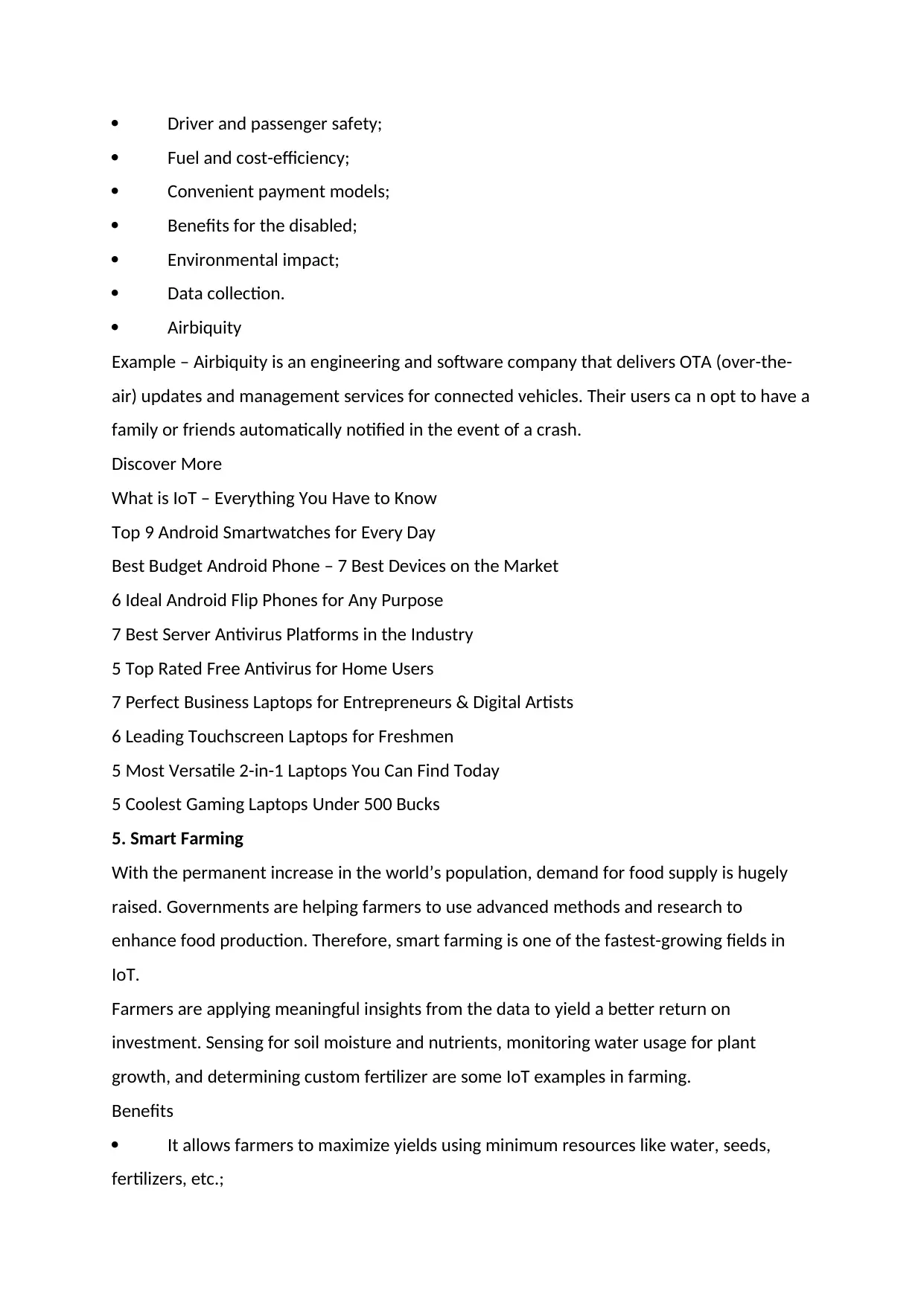
Driver and passenger safety;
Fuel and cost-efficiency;
Convenient payment models;
Benefits for the disabled;
Environmental impact;
Data collection.
Airbiquity
Example – Airbiquity is an engineering and software company that delivers OTA (over-the-
air) updates and management services for connected vehicles. Their users ca n opt to have a
family or friends automatically notified in the event of a crash.
Discover More
What is IoT – Everything You Have to Know
Top 9 Android Smartwatches for Every Day
Best Budget Android Phone – 7 Best Devices on the Market
6 Ideal Android Flip Phones for Any Purpose
7 Best Server Antivirus Platforms in the Industry
5 Top Rated Free Antivirus for Home Users
7 Perfect Business Laptops for Entrepreneurs & Digital Artists
6 Leading Touchscreen Laptops for Freshmen
5 Most Versatile 2-in-1 Laptops You Can Find Today
5 Coolest Gaming Laptops Under 500 Bucks
5. Smart Farming
With the permanent increase in the world’s population, demand for food supply is hugely
raised. Governments are helping farmers to use advanced methods and research to
enhance food production. Therefore, smart farming is one of the fastest-growing fields in
IoT.
Farmers are applying meaningful insights from the data to yield a better return on
investment. Sensing for soil moisture and nutrients, monitoring water usage for plant
growth, and determining custom fertilizer are some IoT examples in farming.
Benefits
It allows farmers to maximize yields using minimum resources like water, seeds,
fertilizers, etc.;
Fuel and cost-efficiency;
Convenient payment models;
Benefits for the disabled;
Environmental impact;
Data collection.
Airbiquity
Example – Airbiquity is an engineering and software company that delivers OTA (over-the-
air) updates and management services for connected vehicles. Their users ca n opt to have a
family or friends automatically notified in the event of a crash.
Discover More
What is IoT – Everything You Have to Know
Top 9 Android Smartwatches for Every Day
Best Budget Android Phone – 7 Best Devices on the Market
6 Ideal Android Flip Phones for Any Purpose
7 Best Server Antivirus Platforms in the Industry
5 Top Rated Free Antivirus for Home Users
7 Perfect Business Laptops for Entrepreneurs & Digital Artists
6 Leading Touchscreen Laptops for Freshmen
5 Most Versatile 2-in-1 Laptops You Can Find Today
5 Coolest Gaming Laptops Under 500 Bucks
5. Smart Farming
With the permanent increase in the world’s population, demand for food supply is hugely
raised. Governments are helping farmers to use advanced methods and research to
enhance food production. Therefore, smart farming is one of the fastest-growing fields in
IoT.
Farmers are applying meaningful insights from the data to yield a better return on
investment. Sensing for soil moisture and nutrients, monitoring water usage for plant
growth, and determining custom fertilizer are some IoT examples in farming.
Benefits
It allows farmers to maximize yields using minimum resources like water, seeds,
fertilizers, etc.;
⊘ This is a preview!⊘
Do you want full access?
Subscribe today to unlock all pages.

Trusted by 1+ million students worldwide
1 out of 17
Related Documents
Your All-in-One AI-Powered Toolkit for Academic Success.
+13062052269
info@desklib.com
Available 24*7 on WhatsApp / Email
![[object Object]](/_next/static/media/star-bottom.7253800d.svg)
Unlock your academic potential
Copyright © 2020–2025 A2Z Services. All Rights Reserved. Developed and managed by ZUCOL.




